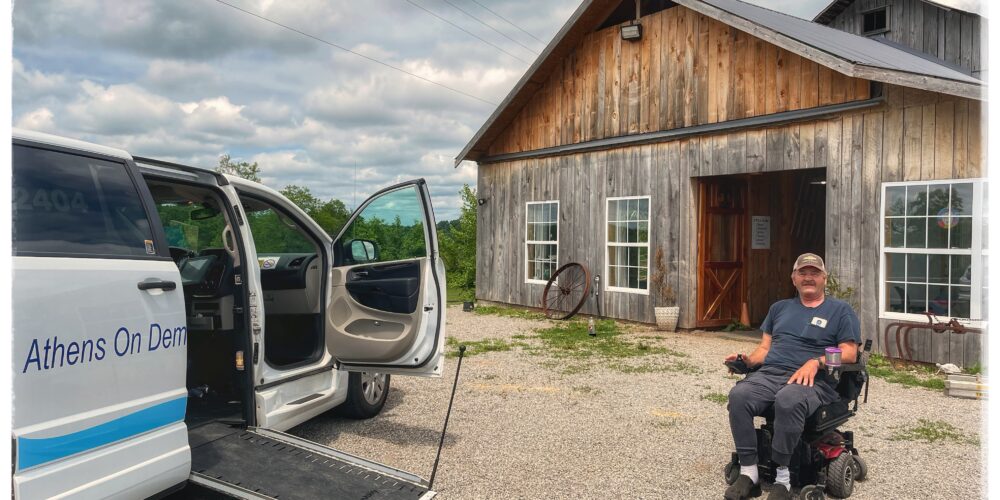An important element of NADTC’s recent online course on rural transportation was dialogue among participants, invited presenters, and NADTC staff. The major topics covered by the course were: program funding; volunteer driver programs; diversity, equity and inclusion (DEI); coordination of services; and technology. Every discussion was grounded in rural community experiences and the unique transportation challenges that rural communities face, including limitations in the availability and accessibility of services, the cost of rides, managing long distance travel, and difficult terrain.
What emerged were rich, participant-led conversations that highlighted local community challenges, but also ideas for action to support and encourage improvements in rural transportation. The following is a sampling of the topics that emerged from the discussion forums:
- Transportation must be recognized and prioritized as a cross-sector issue. In rural communities, access to transportation is more than simply a ride into town. Transportation services mean access to fresh food at the grocery store, the only option to get to an important doctor’s appointment, an opportunity to visit friends and family, or a ride to work. Transportation is directly tied to public health, housing, business activities, and how we can better serve people living in our community. Because it plays such a critical role in the lives of rural residents, it is imperative that transportation be pushed forward as a priority in local and regional conversations around community development.
- Coordination and partnerships among regional transportation and human services providers are needed to strengthen rural mobility resources. Coordination exists on a spectrum that can range from communication and relationship building all the way to the creation of shared routes or group travel beyond jurisdictional boundaries. A common sentiment expressed by participants was interest in finding ways to reduce ride duplication, reduce costs, share resources, and expand ride services through coordinated efforts.
- The Federal Transit Administration’s (FTA) formula grant opportunities are funding resources for rural transportation providers. The forum discussion revealed an audience eager for more information on how federal funding can be used to support local transportation programs, not only for purchasing vehicles but also for expenses such as travel training, way-finding technology, mobility management staff, and volunteer driver programs. Much of the discussion revolved around FTA’s Section 5310 program, provided to states and designated recipients to meet the transportation needs of older adults and people with disabilities. The discussion also highlighted FTA’s Section 5311 program that provides funds for capital, planning, and operating assistance to support public transportation specifically in rural areas with populations of less than 50,000. (NADTC offers a number of resources on FTA’s federal funding programs for those seeking more information.)
- Volunteers are vital for closing the resource gap in transportation availability. Volunteer transportation programs are a successful community mobility option for many older adults, especially those unable to access the traditional public transportation options. One of the most significant challenges is recruitment and retention of drivers. Many programs saw a dramatic decrease in volunteers during the COVID-19 pandemic and still have not experienced a return to pre-pandemic numbers. Recruitment methods vary, but often start with meaningful messaging and the development of personal relationships with volunteers. Participants discussed ways in which their own programs navigate retention with celebrations of volunteer efforts. Some examples included hosting coffee appreciation meetings, spotlighting individuals in social media or newsletters, sending personalized thank you messages of appreciation, and being specific about the impact of a volunteer driver in overcoming an individual’s transportation challenges. (Volunteer driver recruitment resources developed through NADTC’s Every Ride Counts Volunteer Driver Campaign are available for download on the NADTC website.)
- Transportation providers should pursue DEI initiatives and create space for the needs of diverse riders. It is important to seek out underserved and marginalized transportation users to better understand their unique needs and build a system that responds to those needs. Assumptions about users’ needs and desires should be cast aside in favor of making the effort to ask. Listening sessions, surveys, and focus groups are effective approaches for developing targeted programs and services that better serve the needs of specific communities. Other efforts discussed included offering translation services for written materials, using inclusive language, offering accessibility accommodations, ensuring meeting spaces are ADA accessible and seeking opportunities to be curious and open to public feedback.
- Technology is changing the way transportation agencies operate services. Participants shared their experiences with advancements in scheduling systems, navigation, real-time information-sharing, data collection software, and apps to plan or pay for travel. The adoption of technology in rural transportation, and likely for providers in other geographies, is varied and driven partially by the expectations of users and the interest providers have in responding to users’ travel behaviors and maximizing operational efficiency. That being said, technology is not always easy to navigate and some programs have slowed their adoption of technology systems to retain more traditional methods (manual data tracking, using paper maps) based on the interest level of their staff and the clients they serve.
NADTC would also like to acknowledge the time and effort of the speakers who created stimulating and thoughtful presentations for this course. Presenters and their topics included:
- Funding Rural Community Transportation Systems: Justine Young, Chief Executive Officer and Jordan Miles, Director of Transportation, Piedmont Senior Resources Area Agency on Aging, Farmville, VA
- Volunteer Transportation: Sam Purington, Executive Director, Volunteer Transportation Center, Watertown, NY
- Diversity, Equity and Inclusion (DEI) in Rural Transportation Planning: Danny Schnathorst, Outreach Coordinator, Heart of Iowa Regional Transit Agency, Urbandale, IA
- How Technology Supports Rural Transportation Coordination: Linda Mickle, Transportation Program Manager, Lake County Senior Citizens Association (LCSCA), Lakeview, OR
For more information on NADTC courses and other educational events, sign up for the NADTC eNews.

Leave a Reply